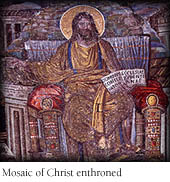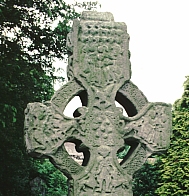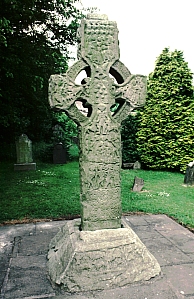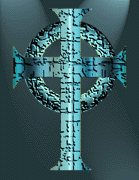|
|
|
The Aryans looked up to the sky and gave it the name Dyaus, from a root-word which means "to shine." When, out of the forces and forms of nature, they would later fashion other gods, this name of Dyaus became Dyaus Pitar, the "Heavenly Father," or "All-Father." The earth they worshipped as the Mother of all.
Their reasoning let them to believe that the Sun was the "off-spring" or product of the Sky god; the Heavenly Father. This "offspring of the Sky-god was none other than "the Son of the Sky", or that the Sun was the "Son of the Heavenly Father", the "Son of the Sun-God", and that the immaculate virgin, the Earth (sometimes it was the dawn or the night), was the Mother of the Sun. Hence we have the Virgin, or Virgo, as one of the signs of the Zodiac.
As the Sun begins the apparent annual northward journey on the 25th of December, this was said to be the birthday of the Sun (all movement commences with birth). This special day, the birthday of the Sun, was observed with great rejoicings. On this day the sign of the Virgin is rising on the eastern horizon, the Sun having reached the winter solstice.
For instance, many of the world's crucified god-men have their traditional birthday on December 25th ("Christmas"). The logical question arises: Why, if Jesus is a historical character, are there are presently two dates for both Christmas and Easter? This purportedly well-known character, who set the world on fire, has no birthdate whatsoever, and the "historical" references and genealogies found in the gospel accounts differ from each other. The gospels are not history at all but a retelling of the Mythos that find their origin in Sun Worship. The historical Jesus is a phantom. "These, which cannot both be historical, are based on the two birthdays of the double Horus in Egypt." In addition, early Christian "doctors" were constantly contradicting themselves as to when exactly "the Lord" died or "ascended to heaven" after "he" was resurrected. Two of the most powerful early bishops, Irenaeus and Papias record that Christ lived to be very old, "flatly denying as 'heresy' the Gospel stories as to his crucifixion at about thirty years of age." (J. Wheless, Forgery in Christianity).
As concerning the above dates, the ancients recognized that (from an earthcentric perspective) the sun makes an annual descent southward until December 21st or 22nd, the winter solstice, when the sun stops moving southerly for three days and then starts to move northward again. During this time, the ancients declared that "God's sun" had "died" for three days and was "born again" on December 25th. The ancients realized quite abundantly that they needed the sun to return every day and that they would be in big trouble if the sun continued to move southward and did not stop and reverse its direction. Thus, these many different cultures celebrated the "Sun of God's" birthday on December 25th. InThe Truth about Jesus, M. Mangasarian states: "The selection of the twenty-fifth of December as his birthday is not only an arbitrary one, but that date, having been from time immemorial dedicated to the Sun, the inference is that the Son of God and the Sun of heaven enjoying the same birthday, were at one time identical beings [notice the Son is identified with the Sun...here comes the Trinity again as the Son is of the same essence as the Sun...reminds us of Nicea Council..right?].The fact that Jesus' death was accompanied with the darkening of the Sun, and that the date of his resurrection is also associated with the position of the Sun at the time of the vernal equinox, is a further intimation that we have in the story of the birth, death, and resurrection of Jesus, an ancient and nearly universal Sun-myth, instead of verifiable historical events."
 and Krishna (as seen in is ascension), are depicted with halos
and Krishna (as seen in is ascension), are depicted with halos ,
hundreds to thousands of years before it became fashionable in
Christianity.
,
hundreds to thousands of years before it became fashionable in
Christianity. Answer
for yourself: Does this remotely sound like what you have been
taught or read about Jesus in the New Testament?
Answer
for yourself: Does this remotely sound like what you have been
taught or read about Jesus in the New Testament?
Answer for yourself: Where does fable end and truth begin?
Mangasarian
states: "Like the dogmas of the Trinity, the virgin birth, and the
resurrection, the sign of
the cross or the cross as an emblem or a symbol, was borrowed from
the more ancient faiths of Asia." Walker states: "Early
Christians even repudiated the cross because it was pagan. . . . Early
images of Jesus represented him not on a cross, but in the guise of the
Osirian or Hermetic 'Good Shepherd,' carrying a lamb." In
Christianity, the original occupant of the cross was a lamb, not a man.
The man hanging on the  cross
did not occur until the 7th cent. C.E. "The stave, stake, prop or
stay of the suffering sun was the Stauros, which was primarily a stake for
supporting, shaped as a cross." This image can be found in crosses
that have a circle on them (the circle is representative of the Sun).
cross
did not occur until the 7th cent. C.E. "The stave, stake, prop or
stay of the suffering sun was the Stauros, which was primarily a stake for
supporting, shaped as a cross." This image can be found in crosses
that have a circle on them (the circle is representative of the Sun).
 Taylor:
"On a Phoenician medal found in the ruins of Citium, and engraved in
Dr. Clarke's Travels, and proved by him to be Phoenician, are inscribed
not only the cross, but the rosary, or string of beads, attached to it,
together with the identical Lamb of God, which taketh away the sins of the
world." Graves: ". . . the consecrated twenty-fifth of March is
also the day marked in our calendars as the date of the conception and
annunciation of the Blessed Virgin Mary." March 25th was considered
the end of the sun's passing through the vernal equinox, when the sun was
"resurrected," i.e., the day was now longer than the night.
Taylor:
"On a Phoenician medal found in the ruins of Citium, and engraved in
Dr. Clarke's Travels, and proved by him to be Phoenician, are inscribed
not only the cross, but the rosary, or string of beads, attached to it,
together with the identical Lamb of God, which taketh away the sins of the
world." Graves: ". . . the consecrated twenty-fifth of March is
also the day marked in our calendars as the date of the conception and
annunciation of the Blessed Virgin Mary." March 25th was considered
the end of the sun's passing through the vernal equinox, when the sun was
"resurrected," i.e., the day was now longer than the night.
Contrary to popular belief, the ancients were not an ignorant and superstitious lot who actually believed their deities to be literal characters. Indeed, this slanderous propaganda has been part of the conspiracy to make the ancients appear as if they were truly the dark and dumb rabble that was in need of the "light of Jesus." "The picture of the New Beginning commonly presented is Rembrandt-like in tone. The whole world around Judea lay in the shadow of outer darkness, when suddenly there was a great light seen at the centre of all, and the face of the startled universe was illuminated by an apparition of the child-Christ lying in the lap of Mary. Such was the dawn of Christianity, in which the Light of the World had come to it at last! That explanation is beautifully simple for the simple-minded; but the picture is purely false - or, in stronger words, it is entirely false." Jacolliot: "We have repudiated Greek and Roman mythologies with disdain. Why, then, admit with respect the mythology of the Jews? Ought the miracles of Jehovah to impress us more that those of Jupiter? . . . I have much more respect for the Greek Jupiter [Zeus] than for the God of Moses; for if he gives some examples not of the purest morality, at least he does not flood his altar with streams of human blood."
The reality is that the ancients were no less advanced in their morals and spiritual practices, and in many cases were far more advanced, than the Christians in their own supposed morality and ideology, which, in its very attempt at historicity, is in actuality a degradation of the ancient Mythos. Indeed, unlike the "superior" Christians, the true intelligentsia amongst the ancients were well aware that their gods were astronomical and atmospheric in nature. Socrates, Plato and Aristotle surely knew that Zeus, the sky god father figure who migrated to Greece from India and/or Egypt, was never a real person, despite the fact that the Greeks have designated on Crete both a birth cave and a death cave of Zeus. As it had with so many preceding purveyors of wisdom and ideologies, the Church ripped off both Aristotle and Plato, presenting their known accomplishments in philosophy. The "Logos" is pure Platonism, which refined the "Word" aspect of the extant Mythos, the Logos in Greece being Hermes, who is also found in Egypt as the "Trismegistus." Cardinal Palavicino is quoted as saying, "Without Aristotle we should be without many Articles of Faith." It is amusing to consider that the omniscient "Lord," who came to deliver a "New Dispensation," needed the writings of Aristotle to determine doctrine for his Church.
In addition, all over the world are to be found sites where this god or that allegedly was born, walked, suffered, died, etc., a common and unremarkable occurrence that is not monopolized by, and did not originate with, Christianity. As concerns the "Jesus Lived in India" theory by Kersten, et al., it is claimed that in Kashmir is a tomb of a traveling prophet named "Yuz Asaf," which is an Arab name that some have attempted to link to "Jesus." Notovich claimed to have found a text in Tibet about the "Life of Saint Issa." It is also claimed that the tombs of "Moses" and "Thomas" are in India. And there are several places where the "Virgin Mary" purportedly rested and/or died. It should be noted that there were innumerable "traveling prophets" throughout the ancient world, all spouting the same parables and platitudes and doing the standard bag of magic tricks, as do the countless Indian yogis of today. It is difficult to believe that the Indians or Tibetans would be very impressed by such stories, since they have had numerous miraculous god-men of their own. It has also been claimed by the Athenians that the olive tree alive today on the Acropolis was miraculously planted by the goddess Athena, an act for which she was honored by having that city-state named after her; and, there are numberless "footprints" of this Buddha and that throughout Buddhist countries. In addition, in the Notovich text concerning the "Life of Saint Issa," which is of late date, it says at the very beginning, "This is what is related on this subject by the merchants who have come from Israel," thus demonstrating both that it is not an eyewitness account of a visit by the Jewish god-man and that there was an extensive trading and brotherhood network which would readily allow for such stories to spread. Again, all around the globe are stories of where this god or that set foot, did miracles, was born or died. This is standard in the world of mythmaking, and it is not an indication or evidence of historicity.
It is evident that there was no single historical person upon whom the Christian religion was founded, and that "Jesus Christ" is a compilation of legends, heroes, gods and god-men. In other words, there is a big difference between the Jesus of History and the Jesus Christ of Faith! There is not adequate room here to go into detail about each god or god-man that contributed to the formation of the Jewish Jesus character; suffice it to say that there is plenty of documentation to show that this issue is not a question of "faith" or "belief." The truth is that during the era this character supposedly lived there was an extensive library at Alexandria and an incredibly nimble Essene brotherhood network that stretched from Europe to China, and this information network had access to numerous manuscripts that told the same narrative portrayed in the New Testament with different place names and ethnicity for the characters. In actuality, the legend of Jesus nearly identically parallels the story of Krishna, for example, even in detail, as was presented by noted mythologist and scholar Gerald Massey over 100 years ago, as well as by Rev. Robert Taylor 160 years ago, among others (Gnostic and Historic Christianity by Massey). See also The Diegesis by Rev. Robert Taylor, The World's Sixteen Crucified Saviors by Kersey Graves, Pagan Christs by J.M. Robertson, any works by Hilton Hotema, Pagan and Christian Creeds by Edward Carpenter, and Deceptions and Myths of the Bible by Lloyd Graham. Although some historicizers may glob onto these dates as proof that the research is outdated, this is simply not true. These numbers are provided here to demonstrate that this truth has been known, and has been suppressed by vested interests, for a long time.
Justin explain this in the following manner: "It having reached the Devil's ears that the prophets had foretold that Christ would come...he [the Devil] set the heathen poets to bring forward a great many who should be called sons of Jove [that is, the sons of God]; the Devil laying his scheme in this to get men to imagine that the true history of Christ was of the same character as the prodigious fables and poetic stories" (Justin, Apol 2).
Julius Frimicus says, "The Devil has his Christs" (Taylor, Diegesis, p. 164).
Answer for yourself: Now don't you think that these Christian Fathers, when cornered by these Pagans and charged with "mimicking" their Pagan Religions, could be more honest than blaming the whole thing on the Devil as counterfeiting the Christian faith in the beginning? I would hope so.